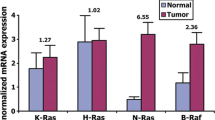Abstract
Although in both human and experimental pathology ras mutations have been related to the origin and progression of follicular-cell tumours, reports differ considerably with respect to the frequency of such mutations. The present paper reports, using direct sequencing, the incidence of Ki-ras mutations (codons 12 and 13) in follicular-cell carcinomas of the thyroid gland in Wistar rats induced by administration of radioactive iodine and potassium perchlorate. Direct sequencing revealed no mutations in the amplified gene segment of any of the 72 carcinoma samples studied. This absence of mutations agrees with some and is in sharp contrast with other previous reports in the literature, both for experimental animals and in studies of human thyroid follicular-cell carcinoma. Our results suggest that Ki-ras activation via mutations at codons 12 and 13 is neither a constant event nor an early event in the development of rat thyroid follicular-cell carcinoma.
Similar content being viewed by others
References
Greaves P, Faccini JM. Endocrine glands. Rat histopathology: A glossary for use in toxicity and carcinogenicity studies. London: Elsevier. 1992, 222–57.
Bos JL. ras oncogenes in human cancer: a review. Cancer Res 1989, 49: 4682–9.
Lemoine NR, Mayall ES, Wyllie FS, et al. Activated ras oncogenes in human thyroid cancers. Cancer Res 1988, 48: 4459–63.
Santoro M, Carlomagno F, Hay ID, et al. RET oncogene activation in human thyroid neoplasms is restricted to the papillary carcinoma subtype. J Clin Invest 1992, 89: 1517–22.
Shi YF, Zou MJ, Schmidt H, et al. High rates of ras codon 61 mutation in thyroid tumours in an iodide-deficient area. Cancer Res 1991, 51: 2690–3.
Lemoine NR, Mayall ES, Williams ED. Agent-specific ras oncogene activation in rat thyroid tumours. Oncogene 1988, 3: 541–4.
Haugen DR, Lillehaug JR, Akslen LA. Enhanced expression of EGF receptor and low frequency of ras mutations in X-ray-induced rat thyroid tumours. Virchows Arch 1999, 435: 434–41.
Napalkov NP. Tumours of the thyroid gland. In: Turusov VS ed. Pathology of tumours in laboratory animals. Lyon: IARC Scientific Publication. 1990, 539–72.
Ni Z, Liu Y, Keshava N, Zhou G, Whong W, Ong T. Analysis of K-ras and p53 mutations in mesotheliomas from humans and rats exposed to asbestos. Mutat Res 2000, 468: 87–92.
Bakiri F, Djemli F, Mokrane LA, Djidel FK. The relative roles of endemic goiter and socioeconomic development status in the prognosis of thyroid carcinoma. Cancer 1988, 82: 1146–53.
Lind P, Langsteger W, Moldnar M, Gallowitsch HJ, Mikosch P, Gomez I. Epidemiology of thyroid disease in iodine sufficiency. Thyroid 1988, 8: 1179–83.
Kawaoi A, Matsumoto H, Suzuki K, Moriyama S. Histogenesis of diisopropanolnitrosamine (DIPN)-induced tumors of the rat thyroid gland. Virchows Arch 1991, 61: 49–56.
Kawaoi A, Moriyama S. Diisopropanolnitrosamine (DIPN) induced rat thyroid lesions. I. A histological classification. Acta Pathol Jpn 1987, 37: 965–73.
Capella G, Matias-Guiu X, Ampudia X, De Leiva A, Perucho M, Prat J. Ras oncogene mutations in thyroid tumours: polymerase chain reaction-restriction-fragment-length polymorphism analysis from paraffin-embedded tissues. Diagn Mol Pathol 1996, 5: 45–52.
Esapa CT, Johnson SJ, Kendall-Taylor P, Lennard TW, Harris PE. Prevalence of Ras mutations in thyroid neoplasia. Clin Endocrinol (Oxf) 1999, 50: 529–35.
Karga H, Lee JK, Vickery AL Jr, Thor A, Gaz RD, Jameson JL. Ras oncogene mutations in benign and malignant thyroid neoplasms. J Clin Endocrinol Metab 1991, 73: 832–6.
Lemoine NR, Mayall ES, Wyllie FS, et al. High frequency of ras oncogene activation in all stages of human thyroid tumorigenesis. Oncogene 1989, 4: 159–64.
Namba H, Rubin SA, Fagin JA. Point mutations of ras oncogenes are an early event in thyroid tumorigenesis. Mol Endocrinol 1990, 4: 1474–9.
Suarez HG, Du Villard JA, Caillou B, et al. Detection of activated ras oncogenes in human thyroid carcinomas. Oncogene 1988, 2: 403–6.
Suarez HG, du Villard JA, Severino M, et al. Presence of mutations in all three ras genes in human thyroid tumors. Oncogene 1990, 5: 565–70.
Wright PA, Lemoine NR, Mayall ES, et al. Papillary and follicular thyroid carcinomas show a different pattern of ras oncogene mutation. Br J Cancer 1989, 60: 576–7.
Kobayashi Y, Kawaoi A, Katoh R. Mutation of ras oncogene in di-isopropanolnitrosamine-induced rat thyroid carcinogenesis. Virchows Arch 2002, 441: 289–95.
Santoro M, Melillo RM, Griego IU. The TRK and RET tyrosine kinase oncogenes cooperate with ras in the neoplastic transformation of a rat thyroid epithelial cell line. Cell Growth Differ 1993, 4: 77–84.
Wright PA, Williams ED, Lemoine NR, Wynford-Thomas D. Radiation-associated and spontaneous human thyroid carcinomas show a different pattern of ras oncogene mutations. Oncogene 1991, 6: 471–3.
Bockhorn M, Frilling A, Kalinin V, Schroder S, Broelsch CE. Absence of H- and K-ras oncogene mutations in sporadic medullary thyroid carcinoma. Exp Clin Endocrinol Diabetes 2000, 108: 49–53.
Nikiforov YE, Nikiforova MN, Gnepp DR, Fagin JA. Prevalence of mutations of ras and p53 in benign and malignant thyroid tumours from children exposed to radiation after the Chernobyl nuclear accident. Oncogene 1996, 13: 687–93.
Suchy B, Waldmann V, Klugbauer S, Rabes HM. Absence of RAS and p53 mutations in thyroid carcinomas of children after Chernobyl in contrast to adult thyroid tumours. Br J Cancer 1988, 77: 952–5.
Fenton DC, Anderson J, Lukes Y, Dinauer CA, Tuttle RM, Francis GL. Ras mutations are uncommon in sporadic thyroid cancer in children and young adults. J Endocrinol Invest 1999, 22: 781–9.
Author information
Authors and Affiliations
Corresponding author
Additional information
Co-first authors
Rights and permissions
About this article
Cite this article
Fernández-Santos, J.M., De-Miguel, M., González-Cámpora, R. et al. Ki-ras mutational analysis in rat follicular-cell proliferative lesions of the thyroid gland induced by radioactive iodine and potassium perchlorate. J Endocrinol Invest 27, 12–17 (2004). https://doi.org/10.1007/BF03350904
Accepted:
Published:
Issue Date:
DOI: https://doi.org/10.1007/BF03350904




